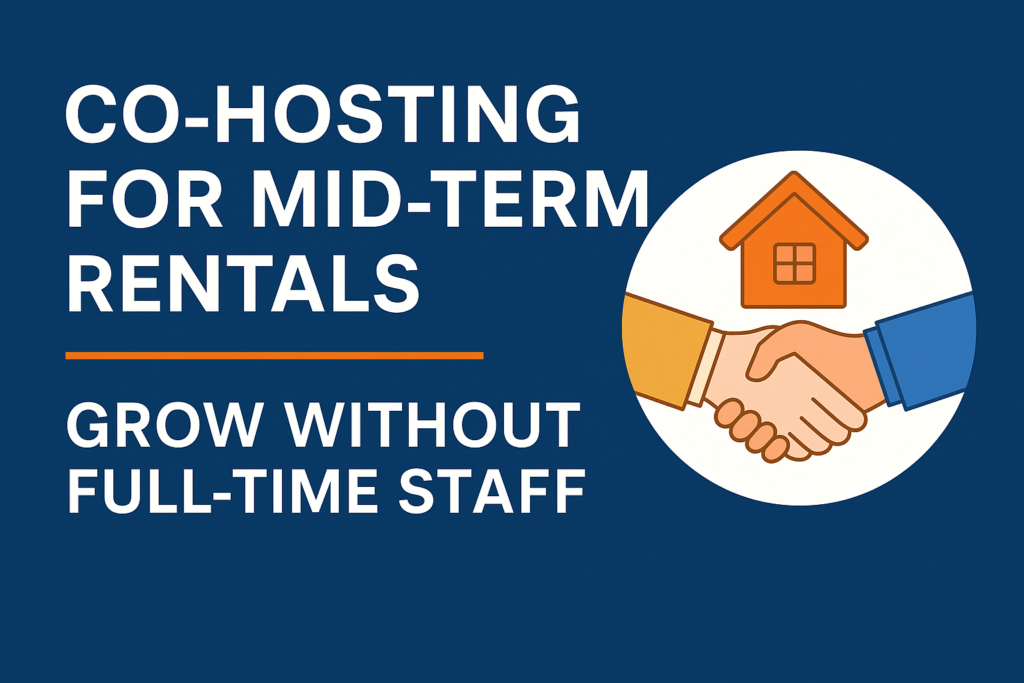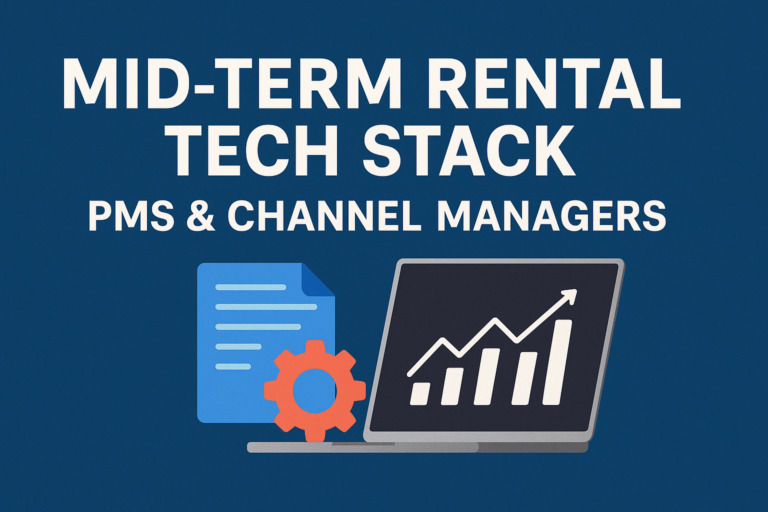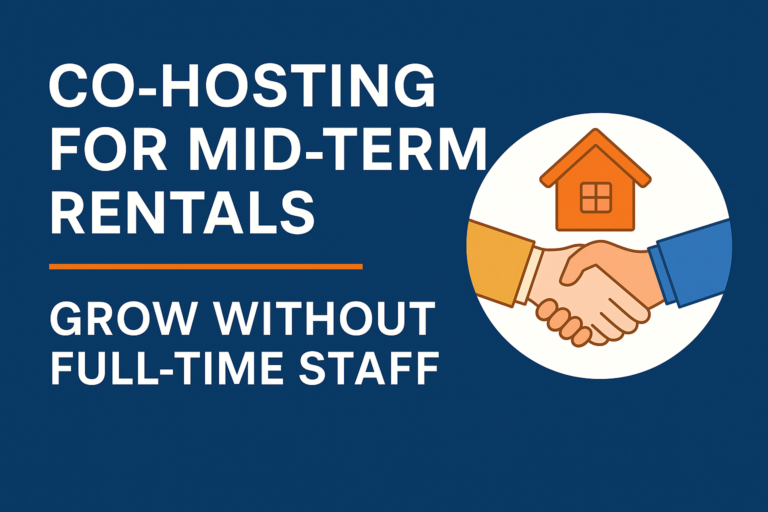Intro — why co-hosting for mid-term rentals works
You don’t need to hire a team to scale. Co-hosting and local partnerships let you add units, cover operations, and keep quality high while avoiding payroll overhead. Done right, partners handle turnovers, guest meet-and-greets, and local ops — you keep control of pricing, standards, and revenue. This post shows partnership models, revenue splits, templates, SOPs, and the KPIs that make co-hosting for mid-term rentals reliable, not risky — a practical module from the Mid-Term Rentals Optimization Playbook — Boost Revenue.
Two partnership models that actually work for mid-term rentals
Pick a model that fits your goals and market.
- Co-host (platform-enabled) — hands-off ops, share revenue
- Partner handles check-ins, cleaning scheduling, and local issues.
- You list and control pricing; co-host gets X% of revenue or a fixed fee per booking.
- Best when you want to scale quickly without local hires.
- Local property partner (JV / white-label) — shared ownership / management
- Partner provides local staff, storage, or a pipeline of units; you provide SOPs, tech, and marketing.
- Profit split or management fee per month.
- Best when you want presence in a new market and are willing to share returns.
Both scale. Co-hosting is faster to start. Partnerships can yield larger margins but need contracts and stronger governance.
How to price co-host agreements (simple, fair structures)
Keep it transparent and testable.
- Revenue share (most common): 15–30% of gross monthly revenue to the co-host for full ops (cleaning + guest handling + local troubleshooting).
- Fixed fee per booking: $40–$120 per turnover + $15–$40 per check-in depending on market. Good when volumes are predictable.
- Hybrid: base fee per cleaning + small revenue share (e.g., $50 + 10%). This aligns incentives.
Pick one, pilot 3 units for 60–90 days, then adjust. Always put payment timing & reconciliation rules in the contract.
Vetting & onboarding co-hosts (don’t skip this)
Red flags cost time and money. Vet thoroughly.
What to verify:
- References from other hosts (ask for 2 recent referrals).
- Proof of insurance or willingness to work under your COI rules.
- Photo samples of past turnovers and a short video walkthrough.
- Basic tools: smartphone for photos, reliable transport, backup cleaner.
- Communication: response test within 2 hours.
Onboard with a short bundle:
- One-page SOPs (check-in, cleaner handoff, maintenance triage).
- Photo checklist template.
- Access instructions and emergency contacts.
- Pricing & payout calendar.
Do a paid test booking and audit the outcome before wider rollout.
SOPs & quality control for co-hosting for mid-term rentals
Standardize everything. One-page SOPs, always.
Must-have SOPs:
- Check-in / key exchange (timing, photo ID, photo of meter on arrival).
- Turnover checklist (what to clean, what to replace, 10 photos required).
- Maintenance triage (who to call for plumbing, AC, locksmith).
- Guest escalation (noise, parties, unauthorized occupants).
- Inventory & damage reporting (photo, cost estimate, timeline).
Quality control loop:
- Co-host uploads 10 photos within 2 hours after turnover.
- You (or VA) validate 1 random turnover weekly for first month.
- Add penalty / bonus clauses for repeat misses.
Short SOPs + accountability reduce disputes and damage claims.
Tools & automations that make partnerships low-friction
You don’t need fancy software to start — just the right automations.
Starter stack:
- Scheduling & tasks: Trello, Asana, or the PMS tasking module.
- Messaging: templated emails + SMS (Twilio) or built-in PMS messages.
- Documentation: Google Drive / Notion for SOPs and checklists.
- Payments: QuickBooks / Stripe payouts or weekly bank transfers with CSV remittance.
- Logging: Google Sheet or Airtable to track turnovers, payments, and QA results.
Automations to build first:
- Booking → create turnover task (with time window + checklist link).
- Turnover complete → co-host uploads photos → trigger QA flag.
- Damage reported → create a claim row in ledger and notify accounting.
Automate reconciliation when possible: export bookings, map payouts, and pay in batch.
Contracts & liability — cover the gaps
You need clear legal guardrails.
Contract essentials:
- Scope of work and exact service list.
- Payment terms and reconciliation cadence.
- Insurance & liability: require co-host to carry local business liability or accept indemnification clauses.
- Data & access: who controls guest data and keys.
- Termination: 30-day exit with inventory handoff and final payout.
- Performance clauses: photo SLA, penalty/bonus terms.
Always include a short annex with the SOP references so the contract stays readable.
Pricing, guest handoff, and guest experience
Make the guest experience seamless when multiple parties touch the stay.
Handoff checklist for co-hosts:
- Pre-arrival message with Wi-Fi, parking, and check-in steps.
- In-person or smart-lock code exchange plus ID verification if required.
- Welcome pack placement and starter supplies check.
- Post-checkout photos and quick snag report.
Keep guest-facing messaging consistent. Use the same welcome email template from the listing team so guests get a unified brand voice.
KPIs to monitor for a co-hosted portfolio
Track these weekly / monthly:
- On-time turnovers (%) — target 98% after 3 months.
- Photo-complete turnovers (%) — target 100% within 2 hours.
- Damage incidents per 100 bookings — aim <2.
- Net revenue per unit vs. baseline — track uplift or drag from partner fees.
- Guest rating and review response time.
Run a monthly reconciliation: bookings → payouts → QA misses → corrective actions.
Common pitfalls & how to avoid them
Don’t learn these the hard way.
- No SLA / vague scope: write clear tasks and acceptance criteria.
- Paying without proofs: require photos and a signed checklist before release.
- One-person dependency: always require backup cleaner or co-host.
- Loose security on keys/access: use smart locks with roll codes or strict key logs.
- Ignoring local rules: ensure co-host knows HOA and local short/mid-term rules.
A small governance process prevents big headaches.
Quick checklist — launch a co-host pilot (30 days)
- Draft one-page SOPs for check-in & turnover.
- Sign a short pilot contract (30–60 days, fixed fee + reconciliation).
- Run a paid test booking and collect photo evidence.
- Audit one turnover end-to-end and add corrective items.
- Finalize revenue share or fixed fee and roll to 2–3 more units.
Do these five steps before you scale to 10+ units.
Sample outreach email to a local co-host (copy/paste) — for co-hosting for mid-term rentals
Subject: Paid co-host opportunity — 1–3 units in [City]
Hi [Name],
I manage furnished 30+ day rentals and need local support for turnovers, guest meets, and light maintenance. Pay: $60/turnover + $20/check-in or 20% revenue share for full ops. Interested in a paid test booking to try the process? I’ll send SOPs and a one-page contract.
— [Your name, phone, company, MiniStays link]
Final word & where to test co-hosting for mid-term rentals first
Co-hosting for mid-term rentals lets you scale fast with low payroll risk. Start with short pilots, enforce SOPs, automate payouts, and measure tightly. If you want a channel that feeds long, furnished stays while you prove local partners, list on MiniStays — it attracts 30+ day guests and reduces mismatch risk as you roll out co-hosted units.
Start hosting on MiniStays → https://ministays.com



